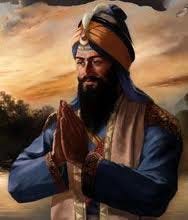The Guru’s Khalsa: Devotion beyond Death
When beauty in the world dies, we all die a bit with it. Sometimes, we orchestrate it ourselves.
One spiritual tradition in India has been very special and beautiful, but its beauty and profundity was probably missed by many. Even those who carried it.
On March 30, 1699 – the 10th Sikh Guru – Guru Gobind Singh called a congregation of his disciples at Anandpur Sahib. The congregation gathered on a hill and a tent was pitched. He turned to the congregation with an open sword and asked for a disciple who was ready to give his head for his Guru. On the third call, a disciple named Daya Ram stepped forward.
For Daya Ram, his Guru at that point represented two things – his Devotion and his Death. Only when his Devotion to his Guru was stronger than his fear of death could he take his first step. There was no real reason for the death, but that Guru needed it. A devotion that transcends all fear of death – reasoned or unreasoned – then it has reached a place from where liberation is a certainty.
The “death scenario” has been used by other Masters as well to take their disciples to liberation, but Guru Gobind Singh used it amazingly.
That day, all the five disciples who stepped forward, attained their highest liberation. The religious say they tasted Amrit. Water was of little consequence, what happened inside the tent transformed spiritual landscape in India in many ways.
From this event, came forth a set of devotees who were very rare. They were innocent as a child, honest and wise as Sages and fearless and ruthless in war as the greatest warriors. These warriors rarely fought for their own motives. Their sword came up as a sacrifice or donation – almost as a contribution to a spiritual fire. Despite knowing the personal gain from a fight for a needy or weak was none, the Saint-cum-Warrior was driven to fight to his last.
Such beings and humans are not normal. They, like the other Bhakti Yogis (Meera, Chaitanya etc) need to live in way that rebels and revolts with the normal societal norms. Devotees, hopeless and remarkable, have been called crazy by all societies. For, the society just cannot understand as to why would someone be naive enough to not think of personal gain and be “foolish” enough to give up his life for someone else, just because it is the “right thing to do”.
Such craziness which adorns the highest devotion is a rare gift to any society. India got it in the form of “Khalsa”. But alas, we never realized the profundity of this gift.
Constantly trying to abuse, make fun of and, indeed, take undue advantage of such beautiful “naivette” that was born out of the highest devotion, we forced the “strange devotees” to rethink their engagement to the society. In an attempt to “align” themselves with a society that couldn’t care for the beauty – the devotee warriors lost their “craziness”.
In midst of such “crazy devotees”, the self-serving society should have aligned itself to their devotion. Unfortunately, for all of us, the opposite happened. Such would have been the severity of the abuse of this devotional gift.
It takes a rare Master to inspire devotees for centuries to transcend their fear of death, not for personal survival (which many do), but for upholding Dharma and righteousness. Such magic is not created easily. It is a loss that every Indian should be ashamed of, because we all had a possibility to transform ourselves, but we lost it.




